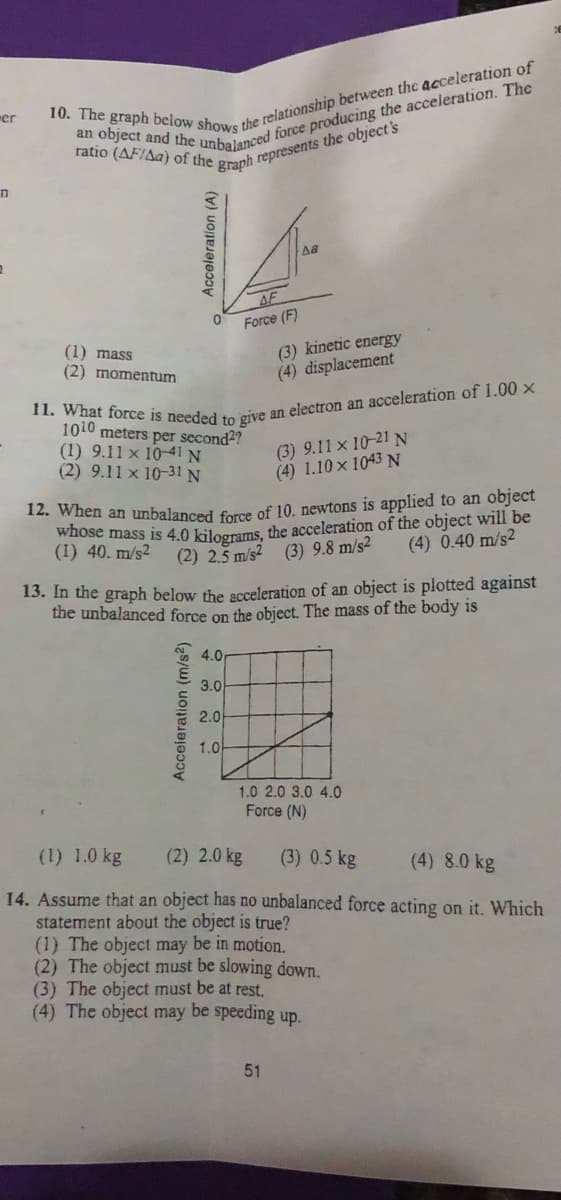Assume that an object has no unbalanced force acting on it. Which statement about the object is true? (1) The object may be in motion. (2) The object must be slowing down. (3) The object must be at rest. (4) The object may be speeding up.
Assume that an object has no unbalanced force acting on it. Which statement about the object is true? (1) The object may be in motion. (2) The object must be slowing down. (3) The object must be at rest. (4) The object may be speeding up.
Modern Physics
3rd Edition
ISBN:9781111794378
Author:Raymond A. Serway, Clement J. Moses, Curt A. Moyer
Publisher:Raymond A. Serway, Clement J. Moses, Curt A. Moyer
Chapter1: Relativity I
Section: Chapter Questions
Problem 2P
Related questions
Topic Video
Question
please help with question number 14

Transcribed Image Text:er
Aa
Force (F)
(3) kinetic energy
(4) displacement
(1) mass
(2) momentum
1010 meters per second2?
(1) 9.11 x 1041 N
(2) 9.11 x 10-31 N
(3) 9.11 x 10-21N
(4) 1.10 x 1043 N
12. When an unbalanced fore of 10. newtons is applied to an object
whose mass is 4.0 kilograms, the acceleration of the object will be
(I) 40. m/s2
(2) 2.5 m/s2 (3) 9.8 m/s²
(4) 0.40 m/s2
13. In the graph below the acceleration of an object is plotted against
the unbalanced force on the object. The mass of the body is
4.0
3.0
2.0
1.0
1.0 2.0 3.0 4.0
Force (N)
(1) 1.0 kg
(2) 2.0 kg
(3) 0.5 kg
(4) 8.0 kg
14. Assume that an object has no unbalanced force acting on it. Which
statement about the object is true?
(1) The object may be in motion.
(2) The object must be slowing down.
(3) The object must be at rest.
(4) The object may be speeding up.
51
Acceieration (m/s2)
Acceleration (A)
Expert Solution
This question has been solved!
Explore an expertly crafted, step-by-step solution for a thorough understanding of key concepts.
This is a popular solution!
Trending now
This is a popular solution!
Step by step
Solved in 2 steps

Knowledge Booster
Learn more about
Need a deep-dive on the concept behind this application? Look no further. Learn more about this topic, physics and related others by exploring similar questions and additional content below.Recommended textbooks for you

Modern Physics
Physics
ISBN:
9781111794378
Author:
Raymond A. Serway, Clement J. Moses, Curt A. Moyer
Publisher:
Cengage Learning

Physics for Scientists and Engineers
Physics
ISBN:
9781337553278
Author:
Raymond A. Serway, John W. Jewett
Publisher:
Cengage Learning

Principles of Physics: A Calculus-Based Text
Physics
ISBN:
9781133104261
Author:
Raymond A. Serway, John W. Jewett
Publisher:
Cengage Learning

Modern Physics
Physics
ISBN:
9781111794378
Author:
Raymond A. Serway, Clement J. Moses, Curt A. Moyer
Publisher:
Cengage Learning

Physics for Scientists and Engineers
Physics
ISBN:
9781337553278
Author:
Raymond A. Serway, John W. Jewett
Publisher:
Cengage Learning

Principles of Physics: A Calculus-Based Text
Physics
ISBN:
9781133104261
Author:
Raymond A. Serway, John W. Jewett
Publisher:
Cengage Learning

Physics for Scientists and Engineers with Modern …
Physics
ISBN:
9781337553292
Author:
Raymond A. Serway, John W. Jewett
Publisher:
Cengage Learning

University Physics Volume 1
Physics
ISBN:
9781938168277
Author:
William Moebs, Samuel J. Ling, Jeff Sanny
Publisher:
OpenStax - Rice University

College Physics
Physics
ISBN:
9781938168000
Author:
Paul Peter Urone, Roger Hinrichs
Publisher:
OpenStax College